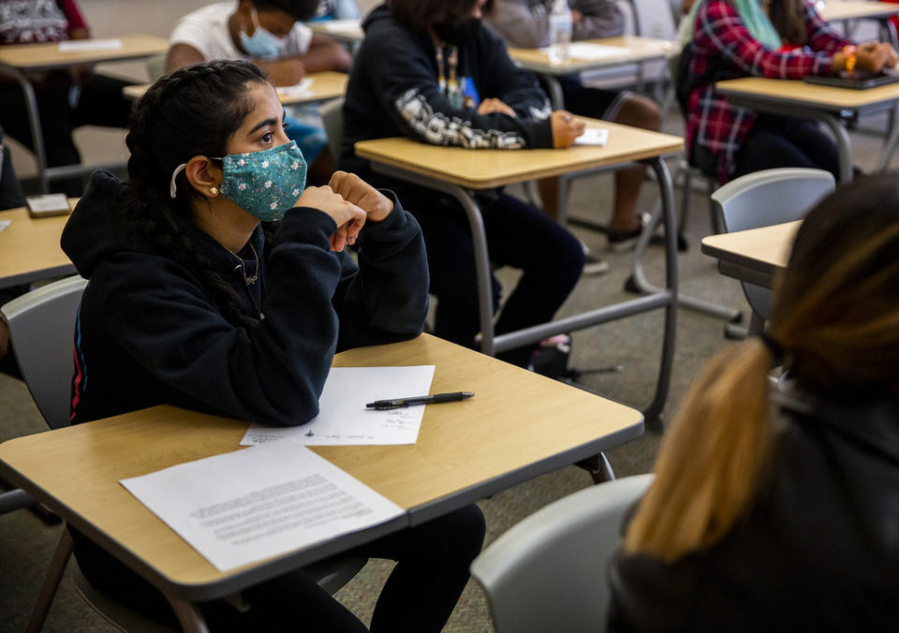Many member states also pledge to train high school teachers to help make the switch.
“Everyone agrees that different college students need different math — quantitative literacy for humanities, stats for most social sciences, calculus for STEM and economics,” said David Kung, the Center’s policy director. “Everyone also agrees that all K-12 students should be in the same math through at least algebra. The big question is where and how to branch [after that], with different students getting different math — and how to do that equitably.”
The Center, which seeks to ensure all children — particularly the underserved — have equitable access to high-quality mathematics and science instruction, began operating out of the University of Texas at Austin in 1991. It has helped shape math for students in that state and has also worked with dozens of districts outside Texas, its efforts funded in part by the Bill and Melinda Gates Foundation.
The revamping of mathematics comes at a critical time: Math proficiency tanked nationwide during and after COVID, prompting educators to seize the opportunity to overhaul the subject with the hope of improving student engagement and outcomes.
Josh Recio, the Center’s course program specialist, said change of this magnitude takes time: It often requires agreement from several entities, including mathematics teachers’ organizations, the legislature and parent and community groups. Then every district in the state has to change its graduation requirements while also incorporating new course material.
“Each step of this process takes coordinated actions that are not easy to achieve,” Recio said. “And yet states are persevering because they can see the benefit to students.”
The Center requires those participating in its Launch Years Initiative to make a three-year commitment; Washington and Georgia are on their second cycle.
Utah started working with the Center around that time, though it wasn’t officially a member state when the program began. Still, the partnership proved fruitful: In its first three years, the state accomplished three essential goals — and has already seen remarkable academic gains.
First, it brought K-12 educators and state college leaders together to identify three entry-level college math courses: statistics, quantitative reasoning and college algebra.
“It really helped to solidify that progression of math content that gets taught all the way through from high school to early college,” said Lindsey Henderson, secondary mathematics specialist with the Utah State Board of Education.
Then it made sure to offer these classes to high school students so they could earn college credit for them prior to graduation.
Finally, Henderson said, the state changed its mathematics offerings so that not all students would be pushed toward calculus: Through pamphlets and online literature, Utah encourages families and students to pick classes aligned with their goals.
“If you want to be a STEM major or work in business, you should consider college algebra,” she said. “If you’re interested in humanities or performing and language arts, you should take quantitative reasoning. If you’re interested in nursing or psychology, you should take statistics.”
Like many other participating states, Washington also reworked Algebra II: It identified the elements of the subject it believes all students need and added data science, quantitative reasoning and mathematical modeling, said Arlene Crum, director of mathematics for the Office of Superintendent of Public Instruction. The new course was piloted in the 2022-23 school year.
“We have multiple graduation pathways within Washington where we support and value students heading in many different directions, not only to a four-year university, but many to two-year colleges, the military or into industry,” Crum said. “So Algebra II should not just be a course that prepares students for the calculus pathway, but it should help students in their thinking for wherever they’re going.”
Washington also reworked its eight-year-old “transition to college” math class, often taken in the 12th grade, bolstering the course’s social-emotional learning elements while also emphasizing statistics.
Oregon also has changed its high school math standards with the goal of increasing student engagement and participation while improving outcomes for all.
It now requires two years of foundational algebra, geometry, and data/statistics and a third year that allows students to choose courses from a variety of options, including quantitative reasoning, data science or advanced mathematics. Students can continue into a fourth year through advanced courses in these pathways, including calculus.
“Increasing the number and percentage of students who excel in math and meet high school mathematics graduation requirements is critical to ensuring future post-secondary success — and keeping career options open to students in a variety of CTE and STEM-based fields,” said Oregon Department of Education spokesman Peter J. Rudy. “This is important for all students, most especially for students who are farthest away from mathematics learning opportunities that bring math to life.”
Henderson, of the Utah State Board of Education, said these changes have helped more students meet and exceed state mathematics requirements: Just 28% of students completed four years of high school mathematics in 2012 compared to 87% in 2020, after the new initiatives were implemented.
And, she said, children with disabilities are faring much better in the subject: While only 43% were earning grade-level mathematics credit in ninth grade in 2012, the figure shot up to 85% in 2020.
“The pandemic has forced us to recognize that student interest in mathematics is really important,” Henderson said. “It helps us to reach really great outcomes. We want to show kids that math is useful. It’s not just a set of procedures that can only be used by a few.”
Disclosure: The Bill & Melinda Gates Foundation provides financial support to The 74.
This story was produced by The 74, a nonprofit, independent news organization focused on education in America.



